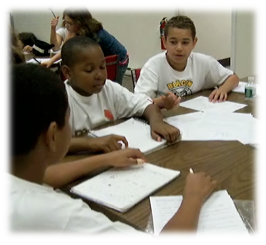Culturally Compatible Environments That Foster Learning
x
1. Cooperative Learning in Elementary School
Cooperative Learning has a research base with supported effectiveness. Peer  collaboration and active listening, teaming, community, cross-curricular connections, and cognitive-friendly differentiation are among the attributes of effective cooperative learning (Beers & Probst, 2007; Immordino-Yang, 2008; Ruckdeschel, 2010). In cooperative learning groups, students often take on roles to contribute to completion of a team project, while following house rules to work cooperatively along the way.
collaboration and active listening, teaming, community, cross-curricular connections, and cognitive-friendly differentiation are among the attributes of effective cooperative learning (Beers & Probst, 2007; Immordino-Yang, 2008; Ruckdeschel, 2010). In cooperative learning groups, students often take on roles to contribute to completion of a team project, while following house rules to work cooperatively along the way.
The overall principles of cooperative learning include the following:
- Heterogeneous Groups: Students work in mixed ability groups from low to high achieving, and mixed ethnically to improve interpersonal and social relations, communication, and thus improved academic performance (Lou, 1996 In: Unrau, 2008).
- Group Accountability: Students work in teams toward a common, specific goal, with each member contributing equally in the form of a product, performance task, or unit outcome.
- Positive interdependence: Students work toward group goals with a group reward at the end, and all are accountable via team interdependence. Activities are structured so that all members take equal responsibility for the end product, and so that none can succeed solely on the effort of another.
- Individual Accountability: In addition to group accountability, cooperative learning has individual accountability designed in. Each member is held accountable for individual participation and effort toward a final team product. Students are tested individually on the requisite knowledge gained, and for individual effort toward the common team goal.
Cooperative Learning Social Roles (see Course Objectives | Research | Materials folder for printable resource)
Students work actively and enthusiastically in cooperative learning groups through simultaneous interaction with other students. But they aren't learning on their own; quite the contrary, there is also a great deal of positive teacher-student and student-to-student peer interaction, where gains are made from one student to another, and with individual student-teacher interactions. Teams don’t compete; rather, they all complete projects that might vary or be differentiated with the same purpose or goal in mind. All group outcomes are completed collaboratively in teams to contribute to a final group project while working toward a whole class objective. Within each team, success is interdependent with each member working equally toward a common purpose.
Cooperative Learning Signals (see Course Objectives | Research | Materials folder for printable resource)
Accountability and Assessment
Individual accountability is based upon individual contribution to a team outcome. It can take many forms depending on what is taught, what the objectives are, and what cooperative learning methods are used. Each student for example, might take an individual test to evaluate learning, with a team grade calculated by averaging the individual quizzes. Or each student might be given an individual grade that hinges on contribution and the team’s final outcome, using an individual rubric and a group rubric.
Cooperative Learning Paired Evaluation (see Course Objectives | Research | Materials folder for printable resource)
Equal participation is important in cooperative learning environments, and is often challenged by students who do the lion’s share of work, and those who rely upon the effort of others for various reasons. When tasks and outcomes are structured, such as in assigning roles, so that all students contribute equally, cooperative learning groups are most successful. For example, rather than assign one specific topic to be discussed, participation can be assured by requiring that each student participate. Students would use a protocol and checklist to ensure this participation, and each group would rate its group using a rubric. This provides for individual and group accountability.
Here are some useful implementation tools that aid in cooperative learning (see the Course Objectives | Research | Materials folder for more):
- Oral Reading Rubric
- Active Listening Checklist
- Active Listening Checklist - 2
- Paraphrasing for Comprehension with Peers
- Literature Circles: Passage Master
- Literature Circles: Illustrator
- Literature Circles: Illustrator/Artist
Room arrangements are necessary for cooperative learning. Below are some possible arrangements:
Paired Desks
Round tables
Rectangle Tables